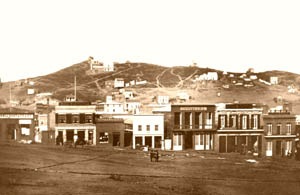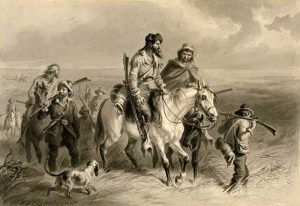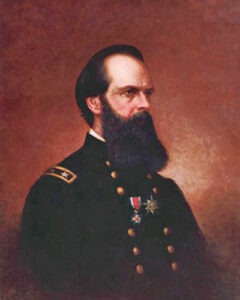
Territorial Governor John Geary.
John White Geary was the third Territorial Governor of Kansas, a lawyer, a Union general in the Civil War, and the 16th governor of Pennsylvania.
Geary was born near Mount Pleasant, Pennsylvania, the son of Richard and Margaret White Geary. He acquired his early education under the instruction of his father, who conducted an academy. He entered Jefferson College in Canonsburg, Pennsylvania, at the age of 14, where he studied civil engineering and law. However, due to his father’s death, he was forced to leave before graduation. Assuming his father’s debts and contributing to the support of his widowed mother and his siblings, he worked at various jobs. He clerked in a store in Pittsburgh and taught school before taking up the work of a civil engineer. He then worked as a surveyor and land speculator in Kentucky. After earning enough money, he returned to college and graduated in 1841.
He then worked as a construction engineer for the Allegheny Portage Railroad. In 1843, he married Margaret Ann Logan, with whom he had two children.
In December 1846, during the Mexican-American War, he raised a company known as the “American Highlanders,” which became a part of the 2nd Pennsylvania Infantry. Serving as a lieutenant colonel, he led the regiment at Chapultepec and was wounded five times. His regiment was attached to the army of General Scott, and for his gallantry at the Belen Gate in Mexico City, Geary was promoted to the rank of colonel. After capturing the Mexican capital, he was placed in charge of the city as commandant. By the end of the war, he had earned the rank of colonel and returned home a war hero.
The discovery of gold in California lured him to the Pacific Coast, and he was appointed postmaster of San Francisco, California, by President John Tyler in January 1849. The following year, he was elected the city’s first alcalde, before California became a state, and then the city’s first mayor.
He returned to Pennsylvania in 1852 because of his wife’s failing health. Unfortunately, she passed away in February 1853.
On July 31, 1856, President Franklin Pierce appointed him as the governor of the Kansas Territory. Geary arrived at Fort Leavenworth on September 9 and went to the territorial capital at Lecompton the following day. Geary believed that his previous government experience would help bring peace to the territory embroiled in the Bleeding Kansas struggle, which pitted abolitionists against pro-slavery advocates.
“I desire to know no party, no section, no North, no South, no East, no West; nothing but Kansas and my country.”
— John White Geary, to his first Kansas audience
Geary disbanded the existing Kansas militia, organized a new state militia, and relied heavily on federal troops to help keep order. Despite his efforts to be a neutral peacemaker, Geary and the pro-slavery legislature clashed. Geary stopped a large force of Missouri border ruffians heading to Lawrence to burn the town again. Additionally, he vetoed a bill that would provide for an election of delegates to the Lecompton Constitutional Convention. The legislature, however, overrode the veto.
At first, Geary adamantly disagreed with the proposals he received from Kansas abolitionists. However, by the 1856 presidential election, he had completely reversed his position and had become intimate friends with Charles Robinson and Samuel Pomeroy. Additionally, he distrusted the pro-slavery forces, and in letters to President Pierce, he blamed them for the deprivations in the territory. He even went so far as to reject his candidacy from the Democratic Party of Kansas for the U.S. Senate. Instead, he worked with the Free-Staters to create a plan for Kansas to be admitted to the Union under the Topeka Constitution as a free state.
Geary soon began to fear for his safety after his private secretary, Dr. John Gihon, was assaulted by pro-slavery bushwhackers. Geary submitted his resignation to incoming President James Buchanan, but instead, Buchanan fired Geary on March 12, 1857.
Armed with two guns, Geary, like Governor Andrew Reeder, left the territory at night on March 21 to escape assassination at the hands of his political party members.
He then returned to his farm in Pennsylvania. Afterward, he spoke at many public meetings about the dangers in Kansas. Although he did not bring peace to the territory, his administration left it more peaceful than before his arrival. He also did much to break the power of the pro-slavery party and contributed materially to the admission of Kansas as a free state.
In 1858, he married Mary Church Goodman, with whom he had two children.
When the Civil War began in 1861, he raised the Twenty-eighth Pennsylvania Infantry and was commissioned colonel of the regiment. Later, he was promoted to brigadier-general and, still later, to major-general. During the Atlanta Campaign and Sherman’s famous march to the sea, he commanded the “White Star” division of the Twentieth Army Corps. On December 22, 1864, he was appointed by Union General William T. Sherman, military governor of Savannah, Georgia.
When the war was over, he was elected governor of Pennsylvania in 1866 and was re-elected at the close of his term.
Geary died in Harrisburg, Pennsylvania, on February 8, 1873.
©Kathy Alexander/Legends of Kansas, updated June 2025.
Also See:
Bleeding Kansas & the Missouri Border War
Missouri Bushwhackers – Attacks Upon Kansas
Sources:
Blackmar, Frank W., Cyclopedia of State History, Volume I, Standard Publishing Company, Chicago, IL, 1912.
Find a Grave
Wikipedia



